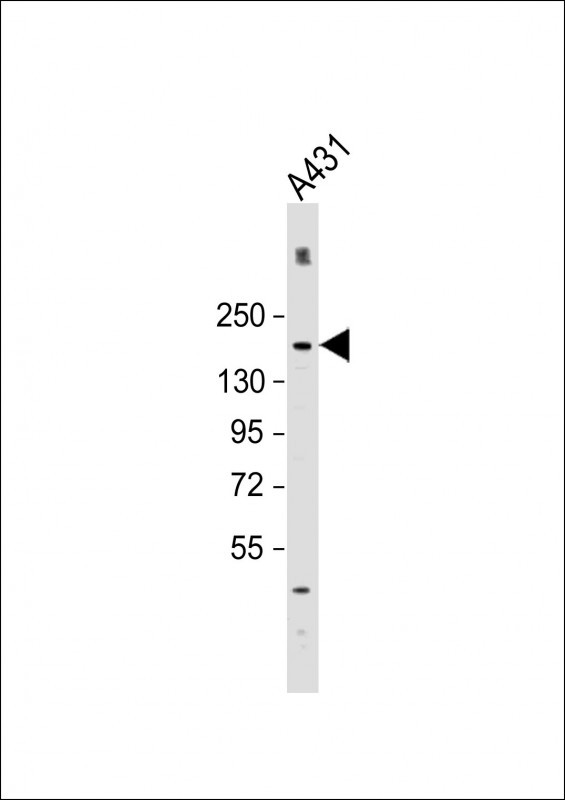
| WB | 1/1000 | Human,Mouse,Rat |
| IF | 咨询技术 | Human,Mouse,Rat |
| IHC | 咨询技术 | Human,Mouse,Rat |
| ICC | 技术咨询 | Human,Mouse,Rat |
| FCM | 咨询技术 | Human,Mouse,Rat |
| Elisa | 咨询技术 | Human,Mouse,Rat |
| Aliases | Histone-lysine N-methyltransferase EHMT2, 211-, Euchromatic histone-lysine N-methyltransferase 2, HLA-B-associated transcript 8, Histone H3-K9 methyltransferase 3, H3-K9-HMTase 3, Lysine N-methyltransferase 1C, Protein G9a, EHMT2, BAT8, C6orf30, G9A, KMT1C, NG36 |
| Entrez GeneID | 10919 |
| WB Predicted band size | 132.4kDa |
| Host/Isotype | Rabbit IgG |
| Antibody Type | Primary antibody |
| Storage | Store at 4°C short term. Aliquot and store at -20°C long term. Avoid freeze/thaw cycles. |
| Species Reactivity | Human, Mouse, Rat |
| Immunogen | This EHMT2 antibody is generated from a rabbit immunized with a KLH conjugated synthetic peptide between 361-395 amino acids from the Central region of human EHMT2. |
+ +
以下是关于EHMT2(G9a)抗体的3篇参考文献及其摘要概括:
---
1. **文献名称**:*Role of the histone H3 lysine 9 methyltransferase G9a in transcriptional regulation*
**作者**:Shinkai Y, Tachibana M
**摘要**:该研究利用EHMT2特异性抗体(如Western blot和ChIP-seq)揭示了G9a在H3K9二甲基化中的核心作用,并证明其通过表观沉默调控胚胎发育和肿瘤抑制基因。
2. **文献名称**:*G9a and Glp methylate lysine 373 in the tumor suppressor p53*
**作者**:Huang J, Dorsey J
**摘要**:通过免疫沉淀结合EHMT2抗体,作者发现G9a/GLP复合物可甲基化非组蛋白靶标p53.抑制其转录活性,为癌症中表观遗传-蛋白修饰互作提供机制解释。
3. **文献名称**:*Pharmacological inhibition of G9a attenuates Th17 cell activation and autoimmune inflammation*
**作者**:Lehnertz B, et al.
**摘要**:研究使用EHMT2抗体(流式细胞术/免疫荧光)验证G9a抑制剂的效果,表明抑制G9a可减少Th17细胞分化,缓解小鼠模型中的自身免疫反应。
---
以上文献均通过EHMT2抗体在分子机制或疾病模型中解析其功能,涵盖表观遗传修饰、癌症及免疫调控等领域。如需具体文献年份或DOI可进一步补充。
The EHMT2 antibody targets the euchromatic histone-lysine N-methyltransferase 2 (EHMT2), also known as G9a, a key enzyme in epigenetic regulation. EHMT2 catalyzes the mono- and dimethylation of histone H3 lysine 9 (H3K9me1/2), a modification associated with transcriptional repression and heterochromatin formation. It plays a critical role in maintaining genomic stability, X-chromosome inactivation, and DNA methylation patterns. Dysregulation of EHMT2 is linked to developmental disorders, cancer progression, and neurological diseases, as its activity influences cell differentiation, proliferation, and apoptosis.
EHMT2 antibodies are essential tools for studying its expression, localization, and function in cellular and disease contexts. They are widely used in techniques like Western blotting, immunohistochemistry, and chromatin immunoprecipitation (ChIP) to investigate EHMT2's role in gene silencing, epigenetic inheritance, and interactions with other chromatin-modifying complexes. Researchers also utilize these antibodies to explore therapeutic targeting of EHMT2 in cancers, where its overexpression often correlates with poor prognosis, or in neurodevelopmental disorders like Kleefstra syndrome, linked to EHMT2 haploinsufficiency. Validation of antibody specificity ensures accurate detection, avoiding cross-reactivity with its homolog EHMT1. Overall, EHMT2 antibodies provide critical insights into epigenetic mechanisms and disease pathways.
×